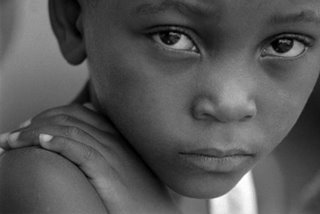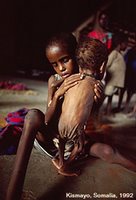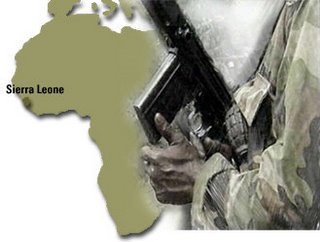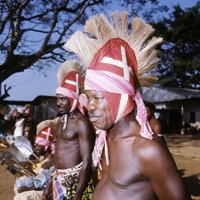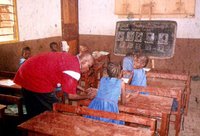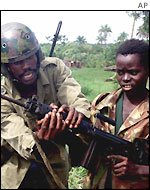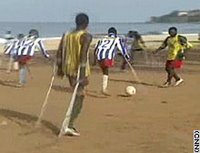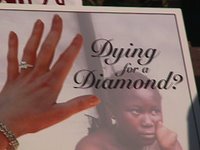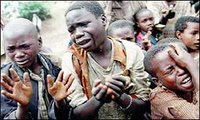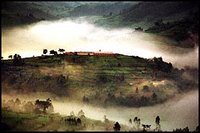 Western Sahara (Arabic: الصحراء الغربية;transliterated: al-Ṣaḥrā' al-Gharbīyah;Spanish : Sahara Occidental) is one of the most sparsely populated territories in the world , mainly consisting of desert flatlands. It is a territory of northwestern Africa, bordered by Morroco to the north,ALgeria in the northeast,Mauritania to the east and south, and the Atlantic Ocean on the west. The largest city is El Aaiún (Laâyoune), which is home to a majority of the population of the territory.
Western Sahara (Arabic: الصحراء الغربية;transliterated: al-Ṣaḥrā' al-Gharbīyah;Spanish : Sahara Occidental) is one of the most sparsely populated territories in the world , mainly consisting of desert flatlands. It is a territory of northwestern Africa, bordered by Morroco to the north,ALgeria in the northeast,Mauritania to the east and south, and the Atlantic Ocean on the west. The largest city is El Aaiún (Laâyoune), which is home to a majority of the population of the territory.
Western Sahara is on the United Nations list of Non-Self-Governing Territories, meaning that in the UN's eyes, the territory has not been decolonized .
The Kingdom of Morocco and the Sahrawi Arab Democratic Republic (SADR) dispute control of the territory. Since a Unitd nations -sponsored cease-fire agreement in 1991, most of the territory has been administered by Morocco, the remainder by the SADR as the Free zone . The SADR is recognized by 46 states, and a full member of the African Union n. Moroccan "territorial integrity" has been supported by members of the Arab League , and by 25 states.
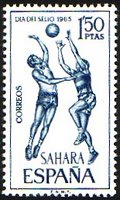 During the first two decades of the 20th century at the end of the colonial penetration of the region,Spain carved out the province of Spanish Sahara through successive wars, treaties and agreements with the local Sahrawi population and France, the competing imperial power. As internal political and social pressures in mainland Spain built up towards the end of Francisco Franco's rule, and as an effect of the global trend in decolonization , Spain began rapidly and even chaotically divesting itself of most of its remaining colonial possessions. Spain planned to divest itself of the Sahara, and in 1974-75 issued promises of a referendum on independence . This had been demanded by the Polisario Front , a Sahrawi nationalist organization fighting the Spanish since 1973.
During the first two decades of the 20th century at the end of the colonial penetration of the region,Spain carved out the province of Spanish Sahara through successive wars, treaties and agreements with the local Sahrawi population and France, the competing imperial power. As internal political and social pressures in mainland Spain built up towards the end of Francisco Franco's rule, and as an effect of the global trend in decolonization , Spain began rapidly and even chaotically divesting itself of most of its remaining colonial possessions. Spain planned to divest itself of the Sahara, and in 1974-75 issued promises of a referendum on independence . This had been demanded by the Polisario Front , a Sahrawi nationalist organization fighting the Spanish since 1973.
However, the territory's neighbours also showed interest in the Spanish Sahara. Both Morocco and Mauritania claimed sovereignty over the territory based on competing traditional claims, arguing that its was artificially separated from their territories by the European colonial powers. The third neighbour of Spanish Sahara, Algeria , viewed these demands with suspicion, influenced also by its long-running rivalry with Morocco. After arguing for a process of decolonization guided by the United Nations , the government of Houari Boumédiénne committed itself in 1975 to assisting the Polisario Front, which opposed both Moroccan and Mauritanian claims and demanded full independence.
 The UN attempted to settle these disputes through a visiting mission in late 1975, as well as a verdict from the International Court of Justice (ICJ), which declared that the Sahrawi people possessed the right of self-determination . On November 6 , 1975 the Green March into Western Sahara began when 350,000 unarmed Moroccans converged on the city of Tarfaya in southern Morocco and waited for a signal from King Hassan II of Morocco to cross into Western Sahara, in order to claim it for Greater Morocco.
The UN attempted to settle these disputes through a visiting mission in late 1975, as well as a verdict from the International Court of Justice (ICJ), which declared that the Sahrawi people possessed the right of self-determination . On November 6 , 1975 the Green March into Western Sahara began when 350,000 unarmed Moroccans converged on the city of Tarfaya in southern Morocco and waited for a signal from King Hassan II of Morocco to cross into Western Sahara, in order to claim it for Greater Morocco.
Demands for independence
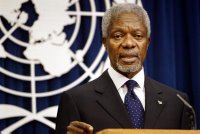 After the death of Franco in November, the new Spanish government abandoned Western Sahara in December, repatriating even Spanish corpses from its cemeteries. Morocco then annexed the northern two-thirds of Western Sahara as its Southern Provinces , while Mauritania took the southern third as Tris al-Gharbiyya . This however met staunch opposition from the Polisario, which had by now gained backing from Algeriaand waged a guerrilla campaign. In 1979, following Mauritania's withdrawal due to pressures from Polisario, Morocco extended its control to the rest of the territory, and gradually contained the guerrillas through setting up the Moroccan Wall . The war ended in a 1991 cease-fire, overseen by the peacekeeping mission MINURSO, under the terms of the UN`s Settlement Plan .
After the death of Franco in November, the new Spanish government abandoned Western Sahara in December, repatriating even Spanish corpses from its cemeteries. Morocco then annexed the northern two-thirds of Western Sahara as its Southern Provinces , while Mauritania took the southern third as Tris al-Gharbiyya . This however met staunch opposition from the Polisario, which had by now gained backing from Algeriaand waged a guerrilla campaign. In 1979, following Mauritania's withdrawal due to pressures from Polisario, Morocco extended its control to the rest of the territory, and gradually contained the guerrillas through setting up the Moroccan Wall . The war ended in a 1991 cease-fire, overseen by the peacekeeping mission MINURSO, under the terms of the UN`s Settlement Plan .
The referendum stalls
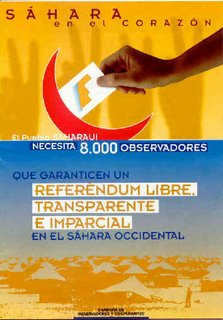 The referendum, originally scheduled for 1992, was planned to give the indigenous population the option between independence or inclusion to Morocco, but has not taken place as of 2006 . At the heart of the dispute lies the question of who can be registered as an indigenous voter. In 1997, the Houston Agreement made another attempt to implement the referendum, but failed.
The referendum, originally scheduled for 1992, was planned to give the indigenous population the option between independence or inclusion to Morocco, but has not taken place as of 2006 . At the heart of the dispute lies the question of who can be registered as an indigenous voter. In 1997, the Houston Agreement made another attempt to implement the referendum, but failed.
Both sides blame each other for the stalling of the referendum. But while the Polisario has consistently asked for the UN to go ahead with the vote, standing only to lose from the status quo, Morocco has been troubled by the risk of losing a referendum or receiving a large enough vote against annexation to undermine years of nationalist rhetoric from the government. Indeed, shortly after the Houston Agreement, the kingdom officially declared that it was "no longer necessary" to include an option of independence on the ballot, offering instead autonomy.Erik Jensen , who played an administrative role in MINURSO, wrote that neither side would agree to a voter registration in which they were destined to lose .
The Baker Plan
 A united States -backed document known as the " James Baker peace peace plan" was discussed by the United Nations Security Council in 2000, and envisioned a future Western Sahara Authority (WSA), to be followed after five years by the referendum. It was rejected by both sides, although it was initially derived from a Moroccan proposal. According to Baker's draft, tens of thousands of post-annexation immigrants from Morocco proper (viewed by Polisario as settlers, but by Morocco as legitimate inhabitants of the area) would be granted the vote in the Sahrawi independence referendum, and the ballot would be split three-ways by the inclusion of an unspecified "autonomy"", further undermining the independence camp. Also, Morocco was allowed to keep its army in the area and to retain the control over all security issues during both the autonomy years and the election.
A united States -backed document known as the " James Baker peace peace plan" was discussed by the United Nations Security Council in 2000, and envisioned a future Western Sahara Authority (WSA), to be followed after five years by the referendum. It was rejected by both sides, although it was initially derived from a Moroccan proposal. According to Baker's draft, tens of thousands of post-annexation immigrants from Morocco proper (viewed by Polisario as settlers, but by Morocco as legitimate inhabitants of the area) would be granted the vote in the Sahrawi independence referendum, and the ballot would be split three-ways by the inclusion of an unspecified "autonomy"", further undermining the independence camp. Also, Morocco was allowed to keep its army in the area and to retain the control over all security issues during both the autonomy years and the election.
In 2003 a new version of the plan was made official, with some additions spelling out the powers of the WSA, making it less reliant on the Moroccan devolution . It also provided further detail on the referendum process in order to make it harder to stall or subvert. This second draft, commonly known as Baker II, was accepted by the Polisario as a "basis of negotiations" to the surprise of many. This appeared to abandon Polisario's previous position of only negotiating based on the standards of voter identification from 1991. After that, the draft quickly garnered widespread international support, culminating in the UN Security Council's unanimous endorsement of the plan in the summer of 2003.
The Spanish census and MINURSO
A 1974 Spanish census claimed there were some 74,000 Sahrawis in the area at the time (in addition to approximately 20,000 Spanish residents), but this number is likely to be on the low side, due to the difficulty in counting a nomad people.
 In December of 1999 the United Nations' MINURSO mission announced that it had identified 86,425 eligible voters for the independence referendum that was supposed to be held under the 1991 Settlement agreement and the 1997 Houston accords. By "eligible voter" the UN referred to any Sahrawi over 18 years of age that was part of the Spanish census or could prove his/her descent from someone who was. These 86,425 Sahrawis were dispersed between Moroccan-controlled Western Sahara and the refugee camps in Algeria, as well as smaller numbers in Mauritania and other places of exile. These numbers cover only Sahrawis 'indigenous' to the Western Sahara during the Spanish colonial period, not the total number of "ethnic" Sahrawis (i.e, members of Sahrawi tribal groupings). The number was highly politically significant due to the expected organization of a referendum on independence.
In December of 1999 the United Nations' MINURSO mission announced that it had identified 86,425 eligible voters for the independence referendum that was supposed to be held under the 1991 Settlement agreement and the 1997 Houston accords. By "eligible voter" the UN referred to any Sahrawi over 18 years of age that was part of the Spanish census or could prove his/her descent from someone who was. These 86,425 Sahrawis were dispersed between Moroccan-controlled Western Sahara and the refugee camps in Algeria, as well as smaller numbers in Mauritania and other places of exile. These numbers cover only Sahrawis 'indigenous' to the Western Sahara during the Spanish colonial period, not the total number of "ethnic" Sahrawis (i.e, members of Sahrawi tribal groupings). The number was highly politically significant due to the expected organization of a referendum on independence.
The Tindouf refugee camps in Algeria, home base of the Polisario, hold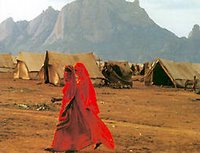 approximately 165,000 Sahrawi refugees from the area according to the last count made by the UN. Morocco disputes this number, saying it is much lower, and insists that many if not most of the refugees are non-Sahrawi Africans who have relocated there in order to profit from aid efforts. The UNHCR and the numerous other aid agencies that are present in the camps have found no evidence of this.
approximately 165,000 Sahrawi refugees from the area according to the last count made by the UN. Morocco disputes this number, saying it is much lower, and insists that many if not most of the refugees are non-Sahrawi Africans who have relocated there in order to profit from aid efforts. The UNHCR and the numerous other aid agencies that are present in the camps have found no evidence of this.
Western Sahara today
 Several international human rights organizations have expressed concern at what they termed abuse by Moroccan security forces, and a number of Sahrawi activists have been jailed. Pro-independence Sahrawi sources, including the Polisario, have given these demonstrations the name "Independence Intifada", while sources supporting the Moroccan claims have attempted to minimize the events as being of limited importance. International press and other media coverage has been sparse, and reporting is complicated by the Moroccan government's policy of strictly controlling independent media coverage within the territory.
Several international human rights organizations have expressed concern at what they termed abuse by Moroccan security forces, and a number of Sahrawi activists have been jailed. Pro-independence Sahrawi sources, including the Polisario, have given these demonstrations the name "Independence Intifada", while sources supporting the Moroccan claims have attempted to minimize the events as being of limited importance. International press and other media coverage has been sparse, and reporting is complicated by the Moroccan government's policy of strictly controlling independent media coverage within the territory.
Demonstrations and protests are still occurring in March 2006, after Morocco declared in February that it was contemplating a plan for devolving a limited variant of autonomy to the territory, but still explicitly refused any referendum on independence. The Polisario Front has intermittently threatened to resume fighting, referring to the Moroccan refusal of a referendum as a breach of the cease-fire terms , but most observers seem to consider armed conflict unlikely.
Human rights
 The Western Sahara conflict has resulted in severe human rights abuses, most notably the displacement of around 200,000 Sahrawi civilians from the country. Both Morocco and the Polisario accuse each other of violating the human rights of the populations under their control.
The Western Sahara conflict has resulted in severe human rights abuses, most notably the displacement of around 200,000 Sahrawi civilians from the country. Both Morocco and the Polisario accuse each other of violating the human rights of the populations under their control.
Morocco has been heavily criticised by international human rights organizations for its actions in Western Sahara, while criticism of the Polisario has been less frequent.During the war, both sides accused each other of targeting civilians . Morocco has been internationally condemned for employing napalm against refugee columns in 1975 and for collective punishment against Sahrawi civilians (see 'The "Disappeared"'). The Moroccan claims of Polisario terrorism has generally received little support abroad, with the USA refusing to include the group on its list of terrorist organizations. Polisario in turn maintained that they are ideologically opposed to terrorism and will only wage a "clean war of national liberation". For allegations of human rights abuse in Tindouf camps, see Human rights in Western Sahara
Western Sahara, while criticism of the Polisario has been less frequent.During the war, both sides accused each other of targeting civilians . Morocco has been internationally condemned for employing napalm against refugee columns in 1975 and for collective punishment against Sahrawi civilians (see 'The "Disappeared"'). The Moroccan claims of Polisario terrorism has generally received little support abroad, with the USA refusing to include the group on its list of terrorist organizations. Polisario in turn maintained that they are ideologically opposed to terrorism and will only wage a "clean war of national liberation". For allegations of human rights abuse in Tindouf camps, see Human rights in Western Sahara
The indigenous population of Western Sahara is known as Sahrawis . These are Hassaniya-speaking tribes of mixed Arab-Berber heritage, effectively continuations of the tribal groupings of Hassaniya speakingtribes extending south into Mauritania and north into Morocco as well as east into Algeria . The Sahrawis are traditionally nomadic bedounis , and can be found in all surrounding countries. War and conflict has lead to major displacements of the population.
 As of July 2004, an estimated 267,405 people (excluding the Moroccan army of some 160,000) live in the Moroccan-controlled parts of Western Sahara. Morocco has engaged in "Moroccanization" of the area, bringing in large numbers of settlers in anticipation of a UN-administered referendum on independence. While many of them are from Sahrawi tribal groups extending up into southern Morocco, some are also non-Sahrawi Moroccans from other regions. The settler population is today thought to outnumber the indigenous Western Sahara Sahrawis. The precise size and composition of the population is subject to political controversy.
As of July 2004, an estimated 267,405 people (excluding the Moroccan army of some 160,000) live in the Moroccan-controlled parts of Western Sahara. Morocco has engaged in "Moroccanization" of the area, bringing in large numbers of settlers in anticipation of a UN-administered referendum on independence. While many of them are from Sahrawi tribal groups extending up into southern Morocco, some are also non-Sahrawi Moroccans from other regions. The settler population is today thought to outnumber the indigenous Western Sahara Sahrawis. The precise size and composition of the population is subject to political controversy.
 The Polisario-controlled parts of Western Sahara are barren and have no resident population, but they are travelled by small numbers of Sahrawis herding camels, going back and forth between the Tindouf area and Mauritania. However, the presence of mines scattered throughout the territory by both the Polisario and the Moroccan army makes it a dangerous way of life.
The Polisario-controlled parts of Western Sahara are barren and have no resident population, but they are travelled by small numbers of Sahrawis herding camels, going back and forth between the Tindouf area and Mauritania. However, the presence of mines scattered throughout the territory by both the Polisario and the Moroccan army makes it a dangerous way of life.
http://www.fuhem.es/portal/areas/paz/observatorio/informes/sahara.htm
http://es.wikipedia.org/wiki/Sahara_Occidental
http://sahara-libre.blogspot.com/
http://www.derechos.org/human-rights/mena/moro/esp.html

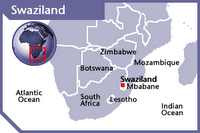 The Kingdom of Swaziland is a small, landlocked country in Southern Africa (one of the smallest on the continent), situated on the eastern slope of the Drakensberg mountains, embedded between South Africa in the west and Mozambique in the east. The country is named after the Swazi, a Bantu tribe. Due in part to a high rate of HIV infection,
The Kingdom of Swaziland is a small, landlocked country in Southern Africa (one of the smallest on the continent), situated on the eastern slope of the Drakensberg mountains, embedded between South Africa in the west and Mozambique in the east. The country is named after the Swazi, a Bantu tribe. Due in part to a high rate of HIV infection, 

 King Mswati III is often strongly criticized for living so lavishly in a nation that is afflicted by the world's highest HIV infection rates at 42.6 percent. His fleet of luxury cars, and the millions spent towards refurbishing his numerous wives' luxury mansions, are at odds with the approximately 34 percent of the population that stand unemployed, and nearly 70 percent of the population who live on less than a dollar a day.
King Mswati III is often strongly criticized for living so lavishly in a nation that is afflicted by the world's highest HIV infection rates at 42.6 percent. His fleet of luxury cars, and the millions spent towards refurbishing his numerous wives' luxury mansions, are at odds with the approximately 34 percent of the population that stand unemployed, and nearly 70 percent of the population who live on less than a dollar a day.  70% of Swazis live in rural areas and are being ravaged by drought and a resulting food crisis that threatens hundreds of thousands with hunger. The past few years have seen wavering economic growth, which has been exacerbated by the economy's inability to create new jobs at the same rate that new job seekers enter the market. This is due largely in part to the country's population growth rate that strains the natural heritage and the country's ability to provide adequate social services , such as health care and education. Overgrazing, soil depletion, drought, and floods are persistent problems. In 2004
70% of Swazis live in rural areas and are being ravaged by drought and a resulting food crisis that threatens hundreds of thousands with hunger. The past few years have seen wavering economic growth, which has been exacerbated by the economy's inability to create new jobs at the same rate that new job seekers enter the market. This is due largely in part to the country's population growth rate that strains the natural heritage and the country's ability to provide adequate social services , such as health care and education. Overgrazing, soil depletion, drought, and floods are persistent problems. In 2004 
